 |
|
 |
| |
Ads by Google, based on your browsing history
|
|
2020
June
29
|
"And number ten semicolon!"
Melody and I have replaced our decrepit 2007 Kenmore refrigerator with a new
LG unit — industrial-looking in its stainless-steel finish; there are no
decorator colors any more! — and it was supposed to be delivered on the 23rd.
Early in the morning, our answer machine got an amusing message punctuated with
the words "And number ten semicolon!" in odd places. To hear part of it,
click here.
It has to be heard to be believed.
What happened? Clearly, some HTML codes such as (line feed)
got treated as text by the speech synthesizer. The result was surreal.
The delivery was scheduled to occur between
noon and 4 p.m., and I had taken time off my consulting work to be ready for it.
The driver was supposed to call us 30 minutes before arrival.
So when 3:30 rolled around and we hadn't heard anything, I called the store.
And thereby began a misadventure. The telephone system at the large store wasn't
working right. They answered my incoming calls but then dropped my call or send me
back to the main menu when trying to transfer me to the appliance department.
At 4 p.m., after wasting half an hour on the phone, I drove to the store.
They were contrite about the phone outage and especially the fact that I had taken
time off work without pay for a delivery that didn't arrive and about which I could not
get any information by phone. They ended up giving me a price break on the refrigerator...
...and delivering it at 7:30 p.m.
Permanent link to this entry
New gadgets
FormFree has been keeping me very busy, but there are a couple of new gadgets around here
(besides the refrigerator) which I'll be writing about.
One is an inexpensive Chinese-made lab power supply
which, as far as I can tell, works fine, but I'm going to make some improvements to the design.
I'm thinking of more high-frequency bypass capacitance at the output (to further reduce noise)
and running the cooling fan at half speed when the thermostat is off. (I found myself wondering
why it had a fan that wasn't running; turns out it switches on when a particular heat sink
reaches 60 C.) More about that soon.
The other, requiring much more attention, is a new
iOptron GEM45 telescope mount
to possibly replace one of my Celestron mounts.
I'll write a lot about this as I get to know it.
Initial impression: A more precise but also more delicate instrument,
not beginner-proof (one can damage it by rough handling).
Permanent link to this entry


|
2020
June
22
|
Globular cluster M12 and two little-known galaxies
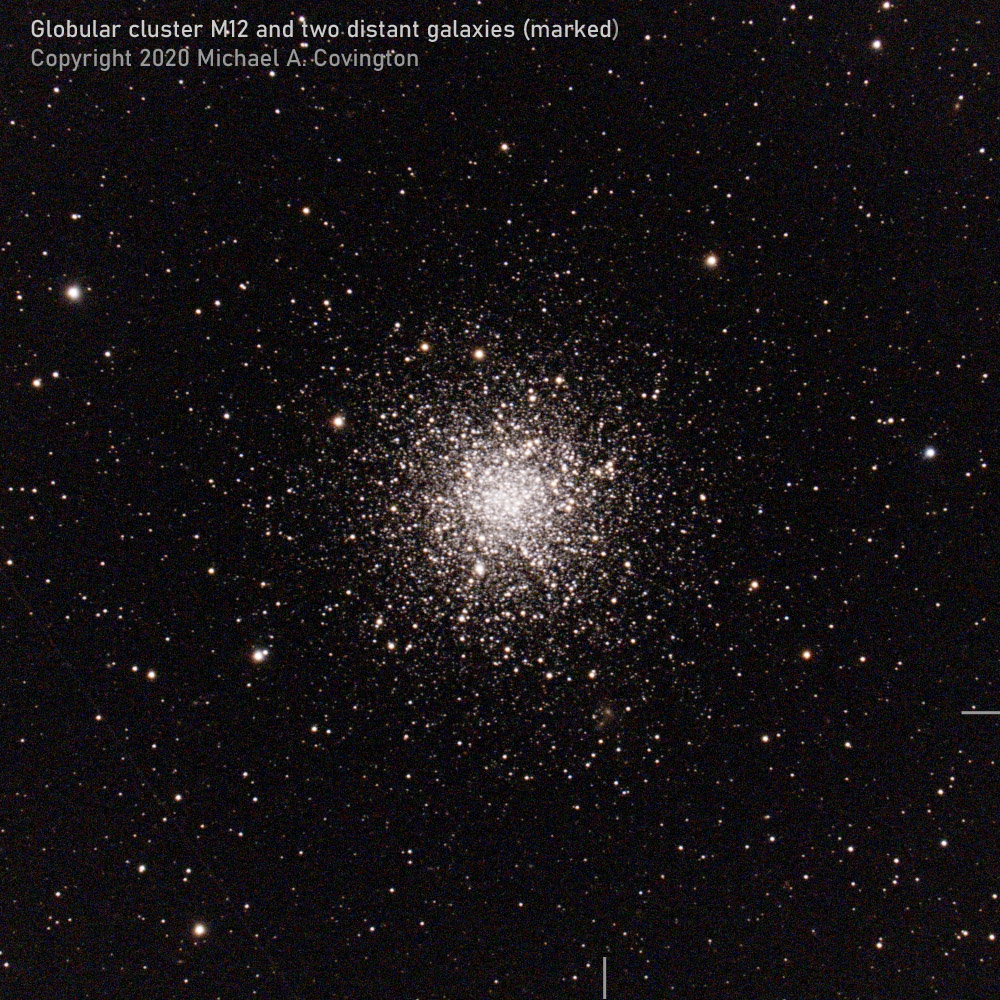
My Father's Day present was being allowed to stay up until 3 a.m. on Saturday night
and Sunday morning taking astrophotos. Here, seen through an 8-inch telescope in my
driveway, is the globular cluster M12.
(Stack of twelve 2-minute exposures, Celestron 8 EdgeHD, f/7 compressor, Nikon D5500 H-alpha,
ISO 400.)
Also, look at the tick-marks at the lower right,
on the right side of the picture and the bottom.
They point to something fuzzy amid the stars on the periphery
of the cluster. It turns out to be a pair of galaxies,
one of them poorly known to science, and the other completely uncatalogued.
Globular clusters are themselves remote objects, on the periphery of our own galaxy,
but the galaxies are much farther away.
One of them is listed in SIMBAD, the professional astronomers' database
(click here to see it);
it is known as 2MASX J16470200-0202314,
from an infrared survey of the sky.
The other galaxy is not listed but is very similar (and you can see both of them in
the picture that comes up on SIMBAD).
In my picture, the galaxies appear to be about 15th magnitude (which is very imprecise, just
a rough guess). SIMBAD says that in infrared, the catalogued one is 11th magnitude. That suggests
there is a lot of interstellar dust in front of it, which is consistent with the part of the sky
we're looking at, close to the plane of our own galaxy and not far from the bright Summer Milky Way.
The first galaxy's redshift has been measured and suggests it's about 1 billion light-years away.
That is 400 times as far as the Andromeda Galaxy.
The globular cluster, by contrast, is only 16,000 light-years away. That, in turn, is more than
1000 times as far as the nearest bright stars.
Permanent link to this entry
Globular cluster M14
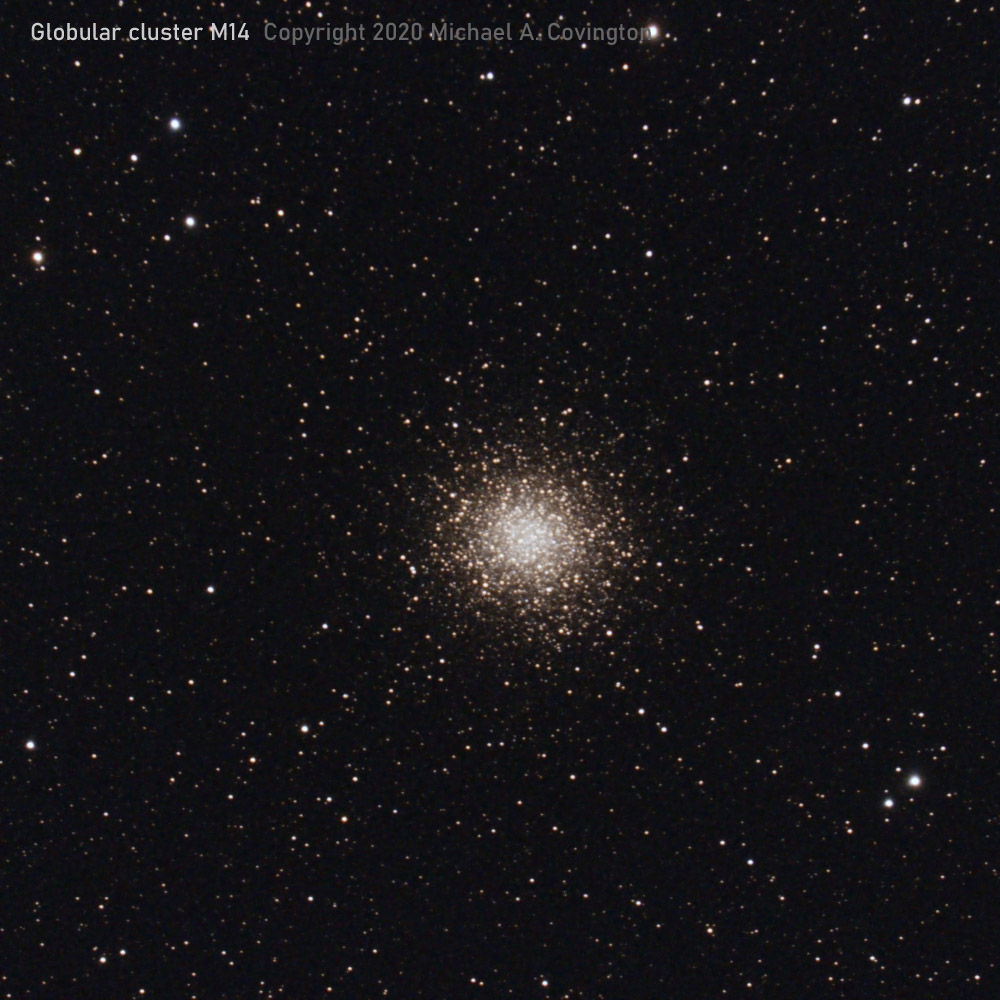
Near M12 in the sky is M14, another globular cluster, which you see here depicted
to the same scale, photographed with the same equipment.
Stack of 15 2-minute exposures.
Permanent link to this entry
Eagle Nebula (M16)
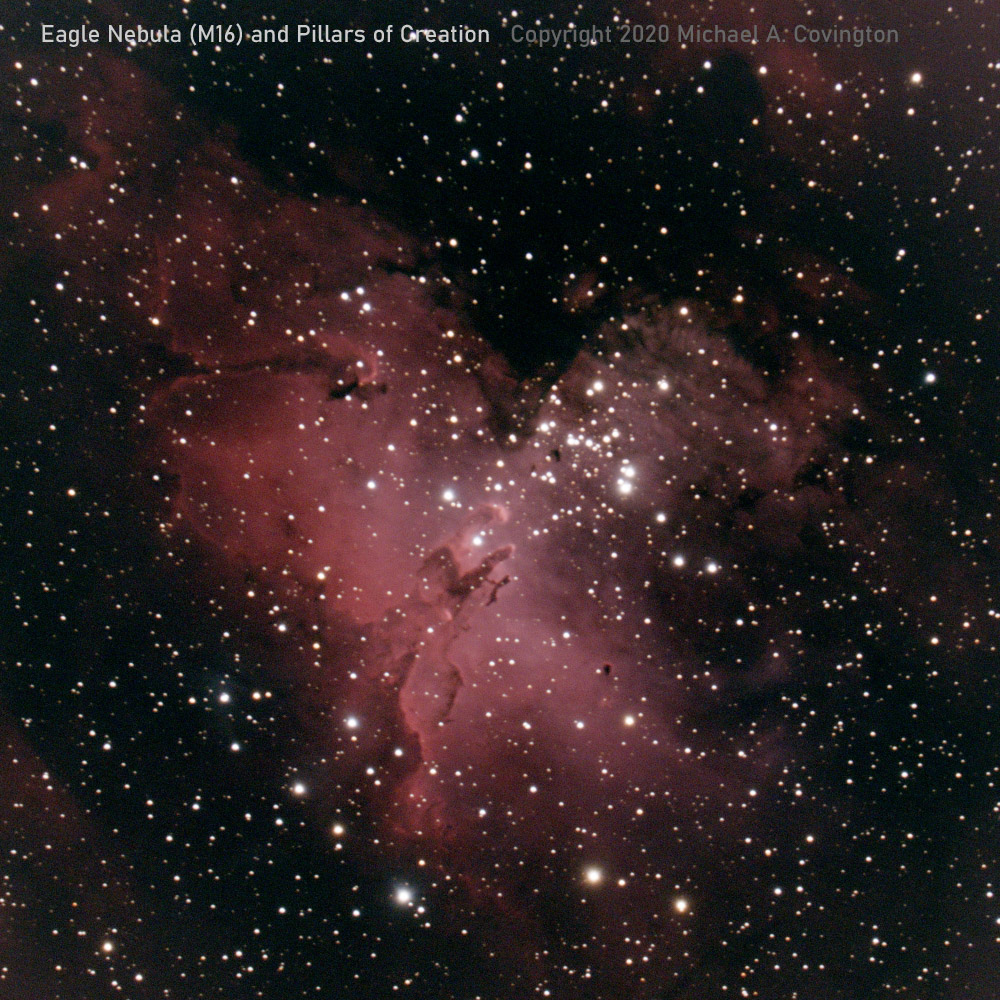
Also from the same photo session, here's the Eagle Nebula, a gas cloud in the
constellation Serpens. (Stack of 19 2-minute exposures.) This is a place where
stars are forming from hydrogen gas, and there are three pillar-shaped areas in
the middle containing especially dense gas (hence dark rather than bright).
The Hubble Space Telescope made them famous as
the "Pillars of Creation."
Most of the light from this cluster is hydrogen-alpha (H-alpha) fluorescence at 656 nm, at
the far red end of the visible spectrum. Many cameras do not respond well to that wavelength.
That's why I used a hydrogen-alpha-modified DSLR, and it made a big difference.
Permanent link to this entry


|
2020
June
19
|
Thank you, Dr. Traupman

Several times I've been asked to name books that made me what I am today, and I don't
think I've remembered to include The New College Latin and English Dictionary, by
the late John C. Traupman (whom I never met). But this book has been with me since
ninth grade; there are three copies of it in this house right now, but the blue one that
you see in the picture is the one that has been my companion for nearly 50 years
and went with me to Cambridge and Yale.
My profession as a linguist began, essentially, with the first day of Latin in high school.
I had been eager to learn Latin and was glad at last to be learning how to analyze a language,
not just speak it.
I have other Latin dictionaries, of course, but this is the one I've always been drawn to.
One important feature is that it uses modern English.
That is, both the lemmas in the English-to-Latin section and the definitions in
the Latin-to-English section use lively, modern language, not Victorian pomposity.
Also (as I learned just recently, but could have guessed) Dr. Traupman was an advocate of
practicing Latin by speaking and writing it. That's what I wanted to do, too — just as I had
done with Spanish, I practiced Latin by writing about my own experiences and thoughts.
This dictionary suited me because its author thought about how to say everything
in Latin, not just how to talk like Caesar or Cicero.
Of course, ipso facto the dictionary is strong on postclassical Latin, which was always a
strong interest of mine. I actually was first drawn into Latin through learning about Renaissance and early
modern astronomers such as Copernicus.
And it is concise. For a student who wants information — not ramblings — it is ideal.
Finally, it includes a handy pronunciation chart, one that inspired a more
elaborate one that I made and distributed through the University for many years.
The original edition has just one fault. For some odd reason, the adjective bellus/a/um 'pretty'
is missing. It of course became a very common word in the Romance languages, and goes back to
rather early Latin (Plautus), but apparently was in disfavor during the golden age, and Traupman
missed it. That omission was corrected later.
Permanent link to this entry


|
2020
June
18
|
A ghost story

Last Father's Day (2019) Cathy and Nathaniel gave me
an unusual pen that includes
two rulers, two screwdrivers, a bubble level, and a touchpad stylus.
I've been using it every day and, in fact, recently bought refills for it.
On Monday night, very late, I noticed that its cap was missing. I searched around my desk and the
place downstairs where I often kept it, the car, the clothes I had just taken off, and the clothes
from the previous day. No sign of it. I actually ordered another pen, figuring I would put its cap
onto the original pen and let it lie capless on the workbench.
On Tuesday, late in the afternoon, I took a walk around the neighborhood. About half a mile west of my house,
lying in the gutter, was a shiny object — the cap!
And it was perfectly clean, as if there had been no rain or even dust since I lost it.
I'm mystified. I suppose it's possible I lost the cap while walking the previous day and didn't
notice it. But the cap is hard to get off (it's for the screwdrivers and is not removed when simply
writing with the pen). And I don't handle the pen while taking walks.
Conceivably, it had been caught in my clothing somehow, and only fell out just before I found it.
But this was the next day, and most of my clothing was different. Could it have been on my shoes
or in my belt?
Unsolved mysteries of the universe!
Permanent link to this entry
Coronavirus uncertainty
Some notes about life in wartime: Most businesses in Georgia (and nationally) are at least partly
open, and the economy seems to be recovering. The toilet-paper famine is winding down; Kroger has
several major brands, though not Scott, and the supply fluctuates irregularly (never fully stocked,
but as of the last few days, never zero). Melody, Sharon, and I are still living a relatively
reclusive life because we are at all higher than average medical risk. I wear masks when I go to stores,
as do about a third of the other people there (more at Kroger, considerably fewer at Lowe's or
Home Depot). And there continues to be bitter controversy; some still claim the entire epidemic
is a hoax (which would imply that those deaths in New York are a hoax too).
The most important thing about the statistics is that they are not the same from state to state.
Here's New York, which you've heard all about:

By Herculean effort, the initial explosive growth was tamed, and the epidemic is clearly on the wane.
Michigan, New Jersey, and several other states follow that pattern.
Now I'm going to show you some other graphs to the same scale (except for slight variation in
the horizontal axis). It's misleading to compare each state only to its own past levels; we
should compare them all to each other. So here is Arizona, where new, explosive growth seems to have
started just recently:
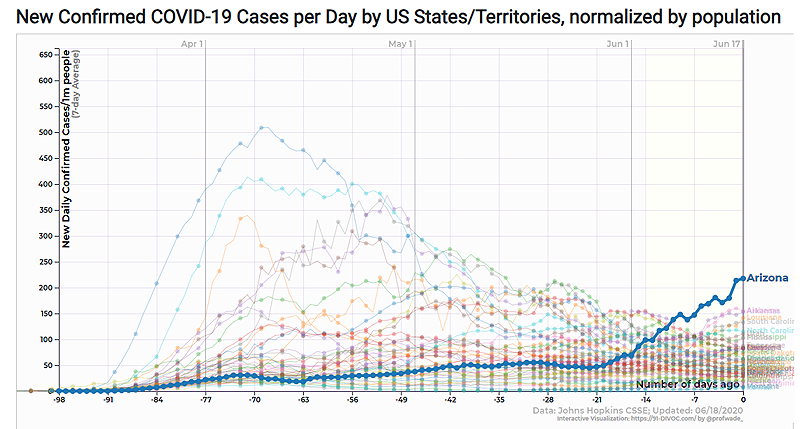
Arizona, you've got a problem. So do several other states. The key factor seems to be the summer
vacation season.
Last, the graph for Georgia is similar to that of the whole United States.
Initial explosive growth was tamed and the curve flattened out,
remaining at a much lower level than New York's,
but after an encouraging
slight dip, it didn't keep going down. Georgia has had an upturn in the past two weeks.
Analysis of (imperfect) state data shows two humps, one connected to the lightening of restrictions
in mid-May and another to the Memorial Day holiday weekend; we hope it will subside after each of
those. The main thing we need is to get more Georgians to wear masks, because we only
need to get R down from 1.1 (its present value) to 0.9 or less, and the question is whether
we have the will to do it.
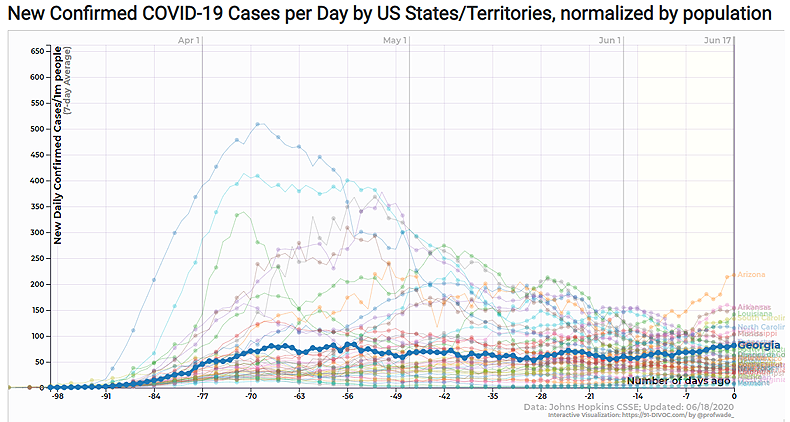
My other speculation is that, like the United States as a whole, Georgia might be a mix of different
areas with different characteristics. For example, that slight upturn in June
mirrors a stronger upturn of the same
shape in South Carolina; maybe part of that extends into part of Georgia.
I haven't dug into the statistics to see if this holds up.
What about testing? You'd think that as we change the amount of testing, we'd change the number
of cases detected. Strangely, that does not seem to happen, at least in Georgia. During the encouraging
dip in May, testing went up and cases continued to go down gradually, leading to very optimistic forecasts.
Then testing went down and cases didn't go down; they went up slightly. I am somewhat puzzled.
However, the hospitalization rate (not shown in these graphs) should be a more reliable indicator,
and it largely confirms the trends I've been mentioning.
It appears that society has decided that Georgia's current level of infection is tolerable
if it doesn't grow explosively again. After all, we have to balance lives lost to coronavirus
versus lives lost to shortages of other medical services, and even to consequences of poverty.
It looks like we'll be taking precautions, to some extent, for several more months, and there will
be some permanent changes in our national economy. I'll write more about that some other time.
Permanent link to this entry
What it's like to go to Deerlick
Many of you know that I do my dark-sky astronomy at
Deerlick Astronomy Village
(although I haven't been there since last fall, because of bad weather and coronavirus).
The first few minutes of
this video by Amy Astro
show, in an amusing way, what it's like to go to Deerlick.
The only difference is that, because I live closer, I don't camp overnight;
instead, I drive back home late at night.
[UPDATE:] Here's an even better video in which Amy
gives a tour of Deerlick, not just a quick look.
Permanent link to this entry


|
2020
June
14
|
Globular cluster M10
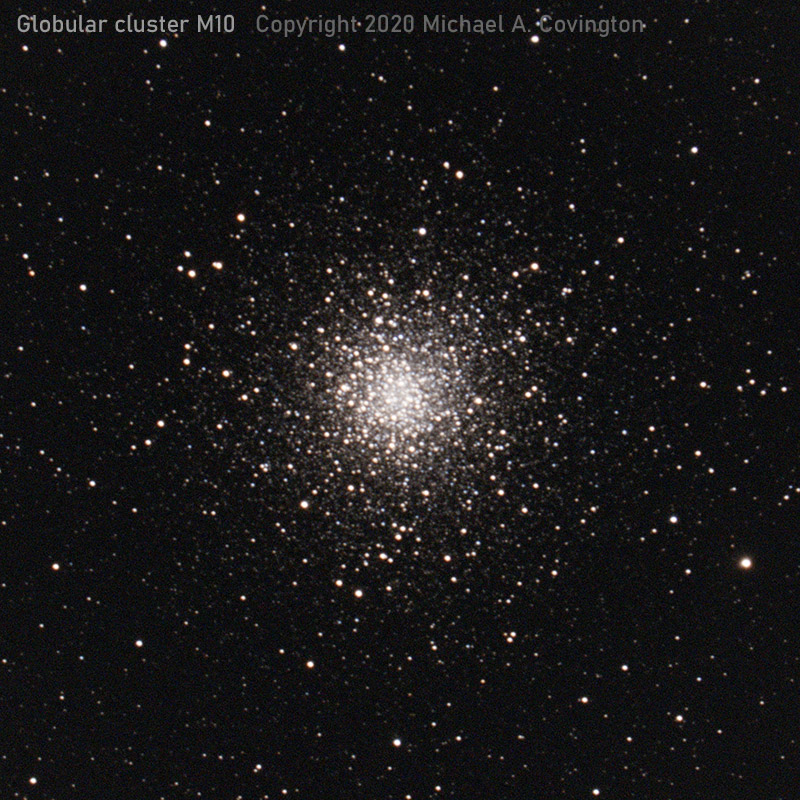
From last night (June 13), with the same equipment as the previous night
(C8 EdgeHD, f/7 reducer, Nikon D5500 at ISO 400).
Stack of 21, count 'em, 21 two-minute exposures, one of the largest sets I have
ever stacked. I set the intervalometer going for 20 exposures, went inside, found that a few of
the 20 had been lost to a passing cloud, and set up another 20, most of which
were lost to some clouds that came and stayed. But I got 21 good ones out of the set.
Permanent link to this entry


|
2020
June
13
|
Globular cluster M4
Finally, a clear moonless night! Or rather three of them, which probably
uses up the year's allotment of good astronomy weather... Two nights ago
(on the 11th) Melody was able to join me for a bit of visual astronomy.
That is noteworthy because for several years she's been having eye problems,
but thanks to successful cataract surgery on June 1, can finally use a telescope.
Using the C8 EdgeHD I showed her Cor Caroli (where she saw a color difference,
the brighter star bluer, which is correct although most people can't see it)
and then M13 (which she saw partly resolved). It is good to be able to share
such things with her again!
Last night, the 12th, I did some photography. Here's the large, nearby, loose
globular cluster M4:
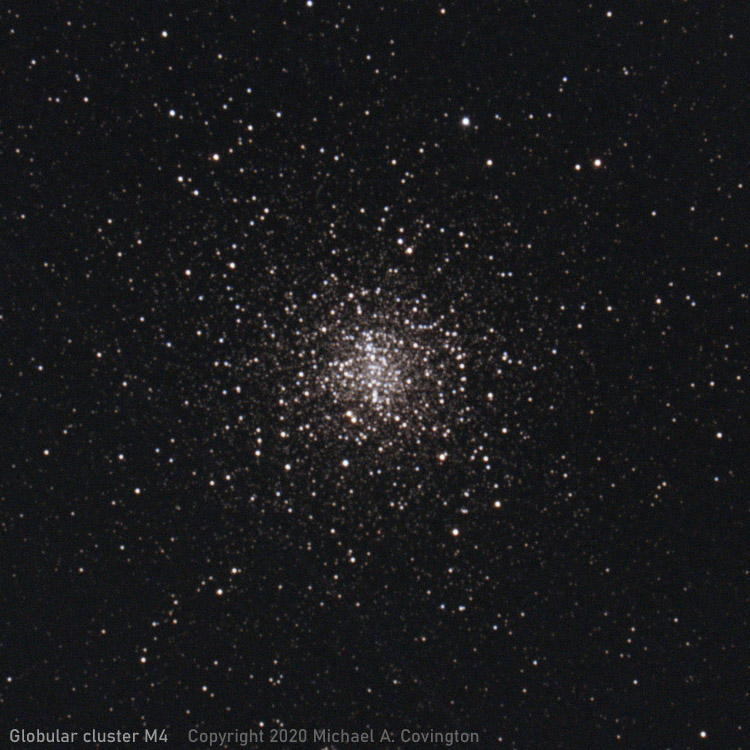
The stars in M4 are arranged in conspicuous rows and streaks, including a "bar"
across the middle.
Stack of five 2-minute exposures at ISO 400, Nikon D5500 (H-alpha mod.),
C8 EdgeHD with f/7 reducer. Only five because the cluster was only briefly
visible through a gap between trees.
Permanent link to this entry
The Ring Nebula (M57)
My other catch last night (June 12) was the Ring Nebula; same setup as above,
but a stack of nine 2-minute exposures, and processed and cropped to give higher
magnification. If you look very carefully, you may see a faint smudge some distance
to the upper right of the nebula; it is the 15th-magnitude galaxy IC 1296.
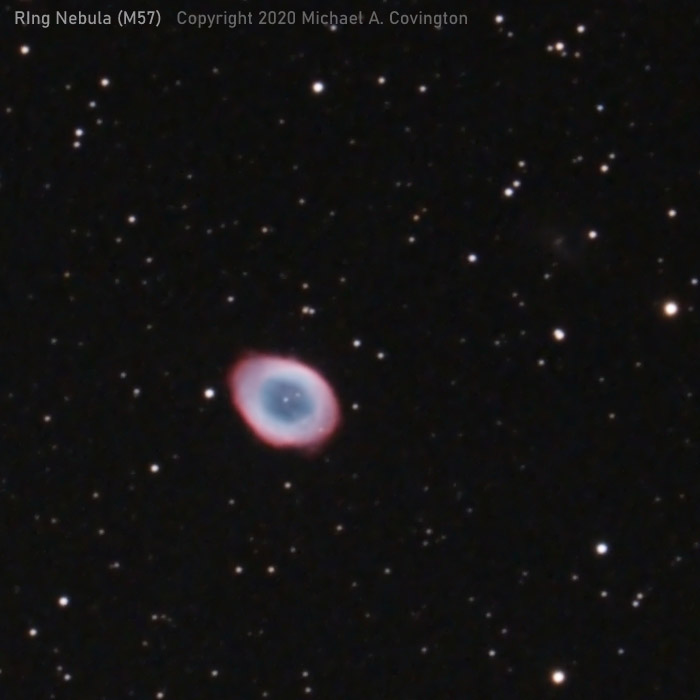
This is a planetary nebula, so called because of its shape; it has nothing to do with
planets, but is in fact the expelled outer atmosphere of a star that blew off a lot of
gas when it ran out of helium fuel. The star survived; you can see it in the center of
the nebula; and it supplies light and radiation to make the nebula glow.
Permanent link to this entry
Recommended product: Velcro One-Wrap cable ties (not their rivals)
You've seen Velcro (or hook-and-loop) cable ties; they vary in quality.
Some use name-brand Velcro, and others use a similar material that is likely
to be stiffer.
But I've found a really good kind, marketed under the Velcro name.
Click here
for an Office Depot link; curiously, I did not find this specific item
on Amazon, though many other varieties are available there.
These are extremely useful at the telescope, to secure cables so
that they will not drag and catch on anything (or even pull in changing directions as
the telescope moves). They're also handy when bundling everything up to store it.
They're thin and flexible; all of each side sticks to the other side, so you don't
have to look for where the Velcro actually is; and you can make a small loop around a
wire to secure the cable tie to it, and then use the rest of it to make a larger
loop when you bundle the whole rest of the cable.
Permanent link to this entry


|
2020
June
9
|
Race relations, continued
One more statement about race relations, and I'll stop.
I am heartened by the way the rioting died out as suddenly as it arose, and
peaceful demonstrations continued.
I am thankful for good police work that protected people who were marching
to protest bad police work.
[Note added:]
Sadly, it did not last. A month and a half later, "protests" continue but
have degenerated into thuggery and crime under the mask of anarchism.
Let no one suppose I am supporting a lot of
what passed for "protests" in late July.
There is a new consensus that race relations
in this country need more attention and effort.
The desegregation of the 1970s did not finish the job, for two reasons.
One is that although intentional discrimination went away, there continued
to be unintended but real discrimination through traditions and the ways people
had long been connected together. People continued going to the same places and
knowing the same people as they had done in segregated days. Unintended segregation
put unintended limits on people's opportunities. Positive efforts to overcome this
are still needed — not laws and regulations, but people acting on their own
initiative.
The second is that 1970s desegregation didn't respect African-American culture.
A common scenario, for example, was abolishing a town's black high school —
a focus
of identity and pride for the local African-American community — and putting everyone in
the traditionally white high school.
Non-whites were offered
equal rights on the condition that they completely adopt the tastes and traditions
of white people. They were often willing to do so,
but I don't think leaving one's heritage behind
should be a requirement. I'm solidly in favor of Western Civilization, but let us acknowledge
that different people enter it by different routes, and those whose heritage comes from
Africa (even via the enslaved South) should be just as welcome as those who bring the heritage
of Italy or Scotland.
Finally: This is about how people treat each other; it is not about slogans, buzzwords,
or philosophical systems. If and when this new awareness of race relations fades away, it
will be because people have exhausted and frustrated each other with tiresome indoctrination.
Don't spend your time promoting your specific definition of "systemic racism."
Get out there and make the world better.
Permanent link to this entry


|
2020
June
6
|
We must oppose racism, not just avoid it
[Updated.]
Many of us have had our attention drawn to the way race relations in this country
have, in many ways, backslid or at least stagnated since the 1970s.
Our liberal wing lost interest in race when it stopped being controversial,
and our conservative wing became alarmingly tolerant of reactionary racism.
We are realizing that it is not enough to avoid practicing or promoting racism;
we must actively oppose and counteract it.
When we say "Black lives matter" we do not mean other lives do not matter.
We mean there is a specific hazard to black lives that needs to be fixed.
(I should also add that most people who say "Black lives matter" are not connected
with, or even thinking of, one or more organizations using that name;
they're just taking a stand about
lives and injustice.)
I have two particular concerns. One is no longer letting white supremacists
pass themselves off as political conservatives. We need to tighten up the
definition of conservative so that it doesn't include them.
I am particularly dismayed at the number of younger adults
who got involved in organized extremism as if it were a cosplay fantasy game, not
thinking it was quite real — until suddenly it was.
That is like the way the Ku Klux Klan often introduced itself to people in the 1920s
as a game played with costumes.
My other concern is doing away with Confederate nostalgia. Many of us were miseducated,
in elementary school in the 1960s, to believe that the Confederate flag stood (only)
for regional pride and self-government. But in fact the Confederacy was formed to
preserve slavery.
(If you don't believe me, read the
states'
own declarations of why they seceded.)
The Confederacy is not a Noble Lost Cause. It was a terrible mistake, although
of course once it got going, many individuals within it meant well and did noble things.
That does not legitimize the cause itself, any more than Russian heroism in WWII
legitimizes Soviet communism.
"But General Lee!" I respond: We can honor the professional achievements and,
later in their lives, the good U.S. citizenship of both Robert E. Lee and
Wernher von Braun without flying the flags under which they fought in the war.
Confederate flags are not welcome where I go.
Permanent link to this entry


|
2020
June
4
|
The videoed riots
The riots of recent days, and the peaceful demonstrations that preceded them, and
even the crimes that provoked the demonstrations, are like none other in the history
of the world, for a reason that has not yet been fully appreciated.
They were photographed and video-recorded constantly, by people on all sides of all
controversies, and the images have been preserved.
For months, we will be finding out more about what really happened.
I think digital image sensors have been a powerful force for good in recent history.
From police body cameras to civilian smartphones, they have made it possible to preserve
whatever the eye can see. If the police cameras happen to all be turned off,
civilian cameras are still on.
There is more evidence than anyone ever wished or feared.
Permanent link to this entry
Farewell, world's last working CDC 6000-series
The first computer I ever programmed was a Control Data CDC 6400, back in 1973.
Thirty-one years later, in 2004, I was amazed to find something similar
(a later-model CYBER 960) still running in Germany, and I was able
to try it out remotely (click here).
The other day I got word that a CDC 6500 (like the 6400 but with two CPUs)
was still running at the
Living Computers Museum in Seattle
and could be accessed through a terminal program that runs in a web browser.
I was all set to take it for a spin when tragic news reached me: The Living Computers
Museum is shutting down, perhaps permanently.
Its CDC 6500 page is archived on The Wayback Machine here.
[Added:] What's worse, digging deeper, I find that
the Museum announced in March that their 6500 had broken down
with a cooling system failure, and as far as I know it has not been repaired.
It appears, however, that the CYBER 960 that I used in 2004 may still
be operating; web page here.
A CDC 6400, or possibly its successor the CYBER 70/74, was involved in
the
day Melody and I met.
Permanent link to this entry
Novis oculis
Well, at least novo oculo (singular).
We are thankful that Melody's cataract surgery on Monday went very well.
Her left eye had developed a cataract that disorted the shape of the lens
and introduced a focusing error that was not correctable even with glasses.
No more! She is still going to need glasses and is waiting for the new lens to settle
down so she can get them; in the meantime I am the chauffeur,
but she's enjoying the view!
Permanent link to this entry


|
2020
June
3
|
Troubled times
Those of us who oppose racism should do it in a thousand or a million different ways, to soak into all the cracks and pores of a society that needs reforming. We should not be expected to accept a single political platform, sociological theory, wordy statement, slogan, or one-size-fits-all solution. We should each do the good we can, where we are, among the people with whom we have contact, and no two situations are alike. What unifies us is respect for our fellow human beings. What matters is not how much power we have, but whether we are always exerting our influence in the right direction.
Permanent link to this entry


|
2020
June
1
|
Moon, unexpectedly sharp
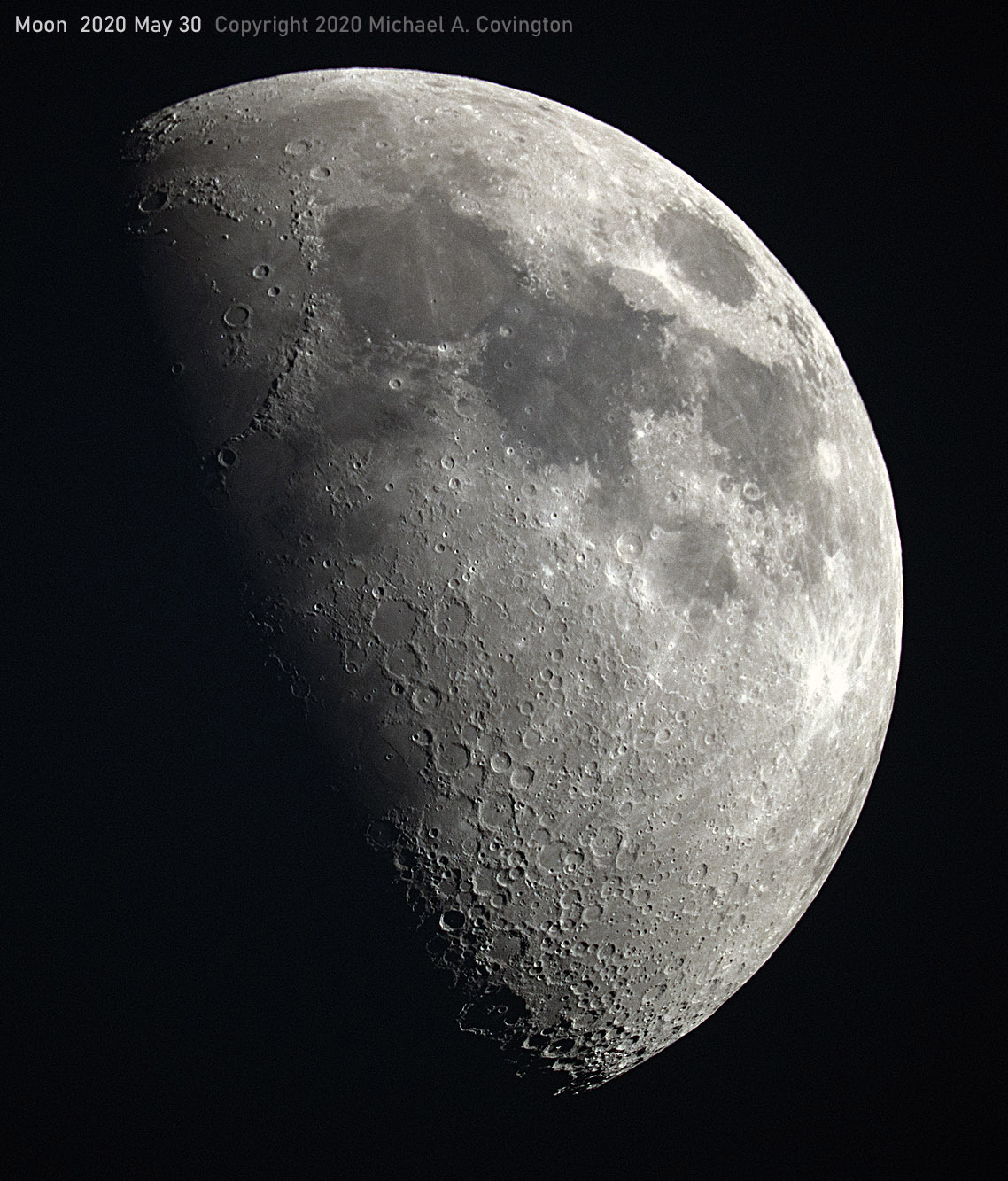
This was just a casual snapshot taken while setting up the telescope, but it came out well.
The quarter moon was high overhead as I took aim at it with my Celestron 8 EdgeHD and
f/7 reducer. Because this optical configuration has a wide, flat field, it gave me a picture
of the whole face of the moon that is sharp all over, often hard to achieve with
conventional astronomical telescopes, which are sharpest in the center.
The other thing that surprised me is that even though it doesn't have electronic first curtain,
the Nikon D5500 had surprisingly little shutter vibration, in fact none noticeable here.
The fact that the exposure was short, 1/500 second, helped with that.
This is a color picture, and the saturation hasn't been manipulated; the color
is realistic. If you look closely, you can see that some of the gray areas (maria)
are more brownish and others are more bluish. This is due to the presence of different
minerals, and once it is pointed out, the color difference is easy to see in any telescope
or even binoculars, but visual observers ignored or denied it until Apollo started
bringing back samples!
Permanent link to this entry
M13 with dust lanes
Using PHD2 to autoguide with a CGEM
Here is the great globular cluster M13 in Hercules, with visible dust lanes
(streaks of interstellar dust) in front of it. The second picture shows where
to look for them. The upside-down-Y-shaped structure at the left is popularly
known as "the propeller."
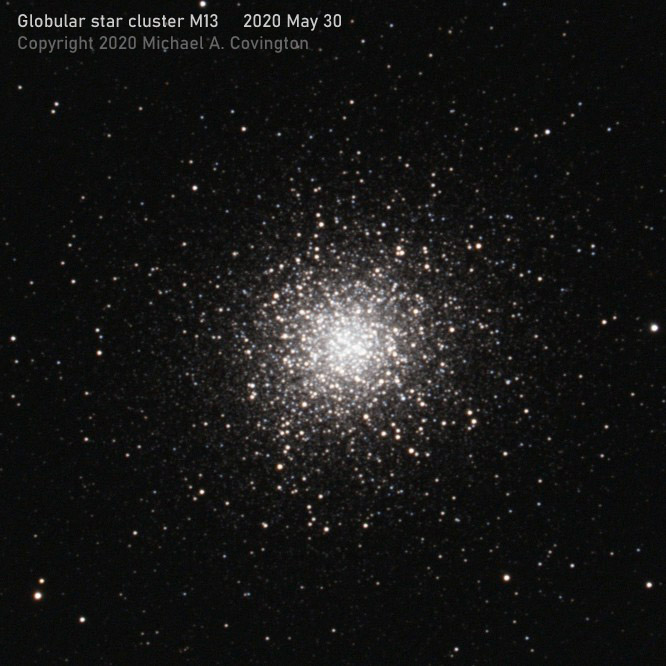

Stack of 18 2-minute exposures, Celestron 8 EdgeHD (200 mm aperture), with f/7 focal
reducer (1400 mm focal length), H-alpha-modified Nikon D5500 at ISO 400.
This picture reflects long-awaited success in getting
PHD2 guiding software
to cooperate with my CGEM mount.
Celestron mounts are designed to have a lot of backlash, and after carefully
adjusting the CGEM, I was able to get its declination backlash down to
a mere 4000 milliseconds of guiding movement (that's how PHD2 measures it).
Part of the secret is setting the declination guide rate to 90% of maximum
(the RA rate should remain at 50%). Then turn on declination backlash compensation
in PHD2 and let it adjust itself. Recent improvements to PHD2 have helped.
Permanent link to this entry
What works in practice also works in theory
My DSLR exposures have been the right length all along
I wish I could remember who referred me to
Dr. Robin
Glover's video about astrophotography with CMOS cameras so I could thank them.
(If they pop up and claim credit, I'll gladly edit this entry.)
The video mostly addresses the question of how long to expose, and the take-home lesson
is that if your sky background is showing up
moderately bright, then you're exposing long enough,
and thermal noise and read noise are unimportant because they are swamped
by the shot noise of the sky background (which would be there with any camera).
So it really is as good to stack ten 2-minute exposures as to make one 20-minute exposure.
Preferable, in fact, because a single long exposure risks
guiding problems, interruptions by aircraft,
and overexposure. For the best dynamic range, you want a large stack of the shortest
exposures that get the sky background up to a reasonable level.
And that level depends on your camera.
Dr. Glover goes through the calculations, using mathematical models of noise
and of the sky background. Using his formula and assuming the read noise in
electrons is 2.5 (which is typical for a Nikon D5500 at ISO 400 or a Canon 60D or
80D at ISO 1600),
here are the recommended exposures:
| |
Rural site
(Bortle 3) |
My house
(Bortle 7) |
| f/4 |
3 min |
20 sec |
| f/7 |
7 min |
2 min |
Expose 1/3 as long if you are using a monochrome sensor, because every pixel gets the
whole spectrum, not just a third of it.
Expose much longer if you are using a narrowband filter.
These are ballpark figures; half or twice as much exposure is practically as good.
The point is, the calculations show us that we don't need to go for 20 minutes,
and, conversely, that 5 seconds would be too little.
The reason the exposure recommendations are not exact is that judgments
can differ as to how much noise is
noticeable in a picture. (Remember that the issue here is not whether there's noise,
but rather whether you'd get visibly less of it with longer exposures.)
To get DSLR sensor noise levels in electrons,
use the chart at PhotonsToPhotos.
With a noisier sensor, you need to expose to get the sky background brighter.
That is also the case if it's warmer and there is more thermal noise.
All of this accords very well with how we've been doing it all along:
Expose so the sky background is moderately bright, definitely distinct
from black.
With a noisier sensor, you need to expose for a brighter sky background,
probably using a higher ISO setting.
Here's my classic example of how the histogram on the camera should look:
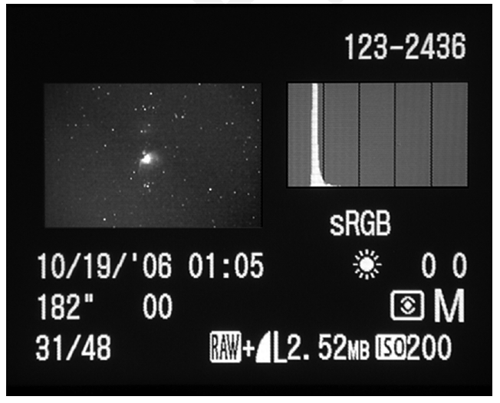
Crucially, the hump isn't touching the left edge. It can be anywhere from
the position shown, all the way over to the middle; it should not be farther
to the left unless you have an unusually low-noise sensor.
The biggest surprise that emerged from this, for me, is that at the settings needed
for best performance, there's not much difference between second-generation and
third-generation Canon DSLRs. Sony (including Nikon) still has a considerable edge.
And of course if you can work at ISO 400 rather than 1600, you have
four times the dynamic range.
Another of Dr. Glover's insights is that there is less need to cool your sensor than you
probably think. If you are having trouble getting enough light to the sensor
(because of a narrowband filter or a high f-ratio),
or if you have an unusually dark sky background (think Arizona desert or Australian Outback),
then expose longer and use a cooled sensor.
But if you're like most of us, you might be better off not bothering with it.
Newer sensors have much less thermal noise than older ones whether CMOS or CCD
(see around 18:35 in the video). I've heard from
people testing late-model DSLRs who were quite surprised at how little the performance
depended on temperature.
And the biggest takeaway is that we're usually not working near the limits of our sensors.
If a lot of different cameras all seem to be working about equally well, it's because
they really are. By experimenting, we've already more or less found out how to get the
best out of each of them.
Permanent link to this entry


|
|
|
This is a private web page,
not hosted or sponsored by the University of Georgia.
Copyright 2020 Michael A. Covington.
Caching by search engines is permitted.
To go to the latest entry every day, bookmark
http://www.covingtoninnovations.com/michael/blog/Default.asp
and if you get the previous month, tell your browser to refresh.
Portrait at top of page by Sharon Covington.
This web site has never collected personal information
and is not affected by GDPR.
Google Ads may use cookies to manage the rotation of ads,
but those cookies are not made available to Covington Innovations.
No personal information is collected or stored by Covington Innovations, and never has been.
This web site is based and served entirely in the United States.
In compliance with U.S. FTC guidelines,
I am glad to point out that unless explicitly
indicated, I do not receive substantial payments, free merchandise, or other remuneration
for reviewing or mentioning products on this web site.
Any remuneration valued at more than about $10 will always be mentioned here,
and in any case my writing about products and dealers is always truthful.
Reviewed
products are usually things I purchased for my own use, or occasionally items
lent to me briefly by manufacturers and described as such.
I am no longer an Amazon Associate, and links to Amazon
no longer pay me a commission for purchases,
even if they still have my code in them.
|
|


















